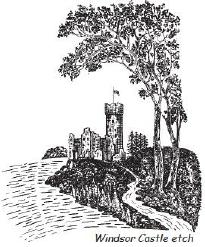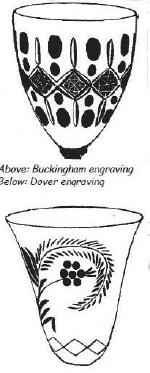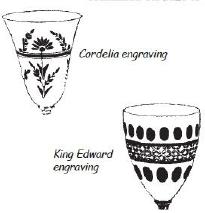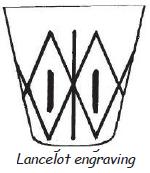OH, BRITANNIA!
by Georgia G. Otten
Issue No. 394 - March 2006
Once again, an idea pops up for
another "seek and find" mission within
various resources. Most everyone
associated with collecting Cambridge
 glass knows the history of the
company and its founder, A. J.
Bennett. This information can be
gleaned from the NCC website using
articles from back issues of the
Crystal Ball. The search engine is
excellent!
glass knows the history of the
company and its founder, A. J.
Bennett. This information can be
gleaned from the NCC website using
articles from back issues of the
Crystal Ball. The search engine is
excellent!
I do not intend to reprint all the information on the company background, just a few tidbits from various articles by various authors to lead into the subject matter. The "idea" I mentioned for this little article is to gather up the British influence on some of the names used by Cambridge Glass Company for etchings, engravings, and even a color.
Arthur J. Bennett (Bennett m.
English is the Medieval form of
Benedict) was born January 18, 1866
in London, England. His apprenticeship
as a young man had been with the
London firm, John Mortlock Co. and
he gained more experience with the
larger firm of Shoolbred's & Barker,
Ltd. He came to America sometime
in 1882 when he was 16 years old and
was first associated with the Jordan
March Co., in Boston. Later he was in
New York. Breaking his affiliations
with B. F. Hunt & Sons, Mr. Bennett
entered the manufacturing field at
Cambridge. Except for a brief period
as general manager for the National
 Glass Co., Mr. Bennett.s complete
attention has been given to the
Cambridge factory.
Glass Co., Mr. Bennett.s complete
attention has been given to the
Cambridge factory.
Mr. Bennett, although living in the United States, frequently traveled back to his native country. He was intrigued with, and had many acquaintances among the Royals. The names of some of the engravings used in Cambridge glass production reflect the admiration Mr. Bennett had for the English Royal family. For example: King Edward, Queen Mary, King George, Crown Prince, Duchess, and Prince Charles.
Another engraving based on an English name is Cordelia. The actual meaning of the name is unknown but could be from a Celtic name meaning "daughter of the sea." This name was first used in this form by Shakespeare, who used it for one of the daughters of King Lear. Another fine engraving with an English influence is #937, Buckingham, which I feel for sure would come from one of the royal residences, Buckingham Palace.
Windsor! Derivation of the name
Windsor is "from a surname which was
from a place meaning 'riverbank with
a windlass' in Old English." Windsor
has been the surname of the royal
family of England since 1917. Arthur
Bennett may have had influence and
selected this royal name for use three
times: There is an engraving # 500
Windsor, there is a color, Windsor
 Blue, described in Colors in Cambridge
Glass as "a tone of icy blue in opaque
glass" and the name was also given
to a fabulous and detailed etching,
Windsor. The etching is of a large
castle (Windsor Castle?) along a body
of water and is combined with a lion
medallion. This etching can be found
Gold encrusted D/972 or Silver
encrusted D/972-S. The etching, plain
or encrusted is a most impressive and
sought after etching among
Cambridge collectors, as are pieces in
Windsor Blue.
Blue, described in Colors in Cambridge
Glass as "a tone of icy blue in opaque
glass" and the name was also given
to a fabulous and detailed etching,
Windsor. The etching is of a large
castle (Windsor Castle?) along a body
of water and is combined with a lion
medallion. This etching can be found
Gold encrusted D/972 or Silver
encrusted D/972-S. The etching, plain
or encrusted is a most impressive and
sought after etching among
Cambridge collectors, as are pieces in
Windsor Blue.
Cambridge had many engravings, over 350, and many of their names were taken from English town names, gardens, castles, beaches and streets. Examples are: Ardsley #1005; Landsdowne #1049; Dover #1034; Bexley #1072; Exeter #810; Avalon #806; Berkeley #851; Chesterfield #952 and Montrose #1004. Additionally there are: Brentwood #854; Mansard #906; Cranston #960 and Whitehall #981. Also chosen for an engraving name is a probable fictional character. A knight from King Arthur's Court, Lancelot, engraving #76 in the Cambridge record.
While most of the names from England
evoke thoughts of royalty, wonderful
 gardens and mysterious castles, I did
find one name for a Cambridge
engraving, Stafford #850, and the
internet travel log reads, "Stafford
is the county town of Staffordshire
in England, and probably the most
boring place on the planet. If you ever
find yourself in Stafford, here are
the best ways to leave." It would
seem that Arthur Bennett liked all
aspects of England and its history! I
am sure there are many other English
based names within the Cambridge
engravings and perhaps the etchings
as well. Please feel free to research
those yourself. I surely did not give
them all.
gardens and mysterious castles, I did
find one name for a Cambridge
engraving, Stafford #850, and the
internet travel log reads, "Stafford
is the county town of Staffordshire
in England, and probably the most
boring place on the planet. If you ever
find yourself in Stafford, here are
the best ways to leave." It would
seem that Arthur Bennett liked all
aspects of England and its history! I
am sure there are many other English
based names within the Cambridge
engravings and perhaps the etchings
as well. Please feel free to research
those yourself. I surely did not give
them all.
With the foresight, wisdom and hard work, Mr. A. J. Bennett, coming from England and borrowing from England's history and daily life, built one of the finest glass production companies, The Cambridge Glass Company, Cambridge, Ohio, USA. "This, then, is the living, active throbbing monument which Arthur Bennett has built and made on his foundation of courage" and which we as collectors of Cambridge glass hold close.
